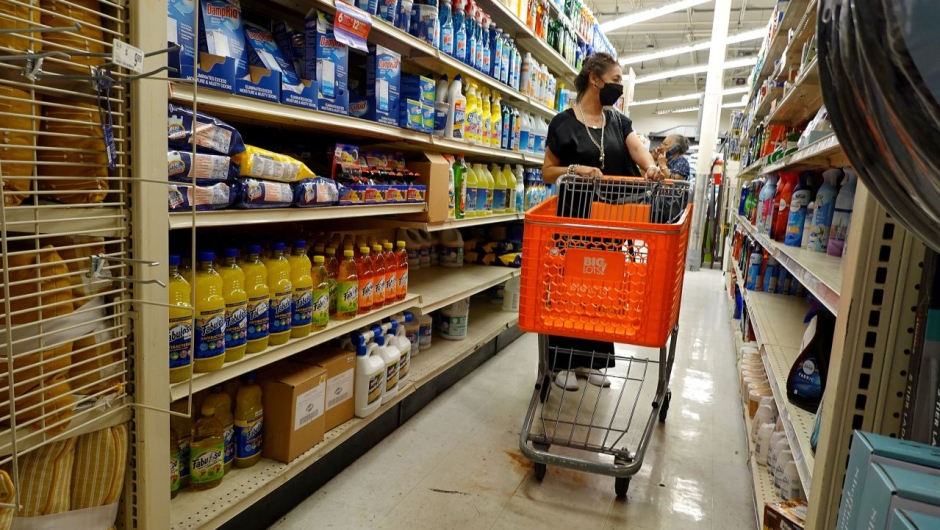Washington () — Florida is the area with the highest inflation in the United States, due to the persistent problem of sky-high housing costs.
The Miami-Fort Lauderdale-West Palm Beach area has the highest rate of inflation of any metropolitan area with more than 2.5 million residents, with an inflation rate of 9% in the 12 months ending in April.
This is more than double the national average of 4%, according to data from the Consumer Price Index (CPI). The Tampa-St. Petersburg-Clearwater metropolitan area posted the third-highest inflation rate in the country, at 7.3% in the year ending in May.
Other metropolitan areas, however, have experienced some positive developments. Minneapolis had an inflation rate of 1.8% in May from a year earlier, the lowest of the 23 metropolitan areas for which the Labor Department publishes inflation data. Urban Hawaii had the second lowest inflation rate at 2%, reflecting the Federal Reserve’s target for its preferred inflation gauge, the personal consumption expenditures index.
Here are some inflation trends in major US cities and the dynamics behind those changes.
An annoying inflation problem in the Sunshine State
In Florida, the increase in population has triggered inflation, especially due to the price of housing. It’s a trend that accelerated during the pandemic, when remote work gave some Americans the freedom to relocate, economists say.
“A lot of people keep coming to Florida because the economy is really strong, and a lot of people like the fact that we don’t have an income tax like in New York, for example,” said Amanda Phalin, an economist at the University of Florida. “And in places like Miami, we see a lot of real estate demand from non-Floridians or non-US investors, generally wealthy people who want to have a nice home here.”
Florida’s population grew more than any other state between July 2021 and July 2022 due to internal migration, according to the latest estimates from the Census Bureau. During that same period, Florida also had the fastest population growth in percentage, the first time it has held that top spot since 1957.
Housing costs account for nearly a third of the Labor Department’s Consumer Price Index, and population growth heavily influences that component. The influx of residents drives demand for transportation, services, and housing in the local economy. This has pushed up inflation rates.
Rising interest rates, housing shortages in cities like Miami and higher homeowners insurance have also pushed up home prices, according to Phalin.
“Both the rental and purchase markets are experiencing upward price pressure from all of these factors,” Phalin said. He added that there is a shortage of available rental units because “many houses are becoming Airbnbs and some homeowners associations prohibit people from renting out their houses.”
All of that has resulted in a growing affordability problem for residents who have lived in cities like Miami and Tampa Bay for decades or their entire lives.
Advances in inflation
The cost of housing also looms over the metro area with the lowest inflation rate: Minneapolis and St. Paul. “The cost of housing grew faster in Minneapolis and peaked a little earlier,” says Tyler Schipper, an associate professor of economics at the University of St. Thomas in Minneapolis.
“They peaked about six months earlier than the average for the rest of the country.”
How the Bureau of Labor Statistics tabulates housing costs in the CPI and when the readings are collected for different regions is also likely to play a role.
Housing has a lot of weight in the CPI calculations. However, it lags significantly behind due to how infrequently data is collected (every six months, versus months to two months for other CPI prices) and how infrequently rents change (many contracts rent is 12 months, and rents often go up when a tenant leaves).
“I think this is leading to this divergence where inflation peaked around the same time [en el área metropolitana de Minneapolis-Saint Paul y en el país]but it has declined faster here than in the rest of the country,” he said.
The increase in the construction of multi-family homes has contributed to this, which has put more apartments on the market and has reduced rents.
Last year, multi-family permits accounted for nearly half of all housing permits issued in the Federal Reserve Bank of Minneapolis district, which stretches from the Midwest to the Mountain States. This activity, the highest recorded in the district, according to the regional Federal Reserve, is especially evident in southeast Minnesota, where large apartment projects flourish in the Minneapolis-Saint Paul metropolitan area, also called the Twin Cities.
Although the Twin Cities’ inflation rate is currently the lowest among large cities, residents may not perceive it that way, Schipper said.
“Because the CPI is so weighted toward housing, our headline numbers still looked great, but food prices rose and stayed higher relative to other metro areas,” he said. “It’s going to be hard to convince people that inflation is improving if food prices keep going up.”
Minneapolis resident Latoya Rogers doesn’t get much price relief when she goes shopping. Other than picking up an item or two if she’s near Target or Cub, most of her shopping is at Costco or Sam’s Club, she said.
“I do a lot of budgeting because things are so expensive these days,” he said during a quick visit to Target in south Minneapolis. “Buying in bulk lasts you longer.”
It’s still high, but it’s better
At one point, the Atlanta-Sandy Springs-Roswell metropolitan area was the epicenter of inflation in the United States.
Inflation spiked in Atlanta for the same reason as in other southern cities: The population grew, fueled by Americans fleeing expensive coastal cities.
However, inflation in this metropolitan area has fallen steadily in the past year, as supply and demand in the region’s real estate market have become more balanced as migration to the city has slowed.
Atlanta posted an inflation rate of 5.8% in the 12 months ending in April, about half the peak of 11.7% reached in August 2022.
“If you look at the data, the availability of homes in Atlanta has gone up quite a bit from a year ago, so there’s a lot more supply on the market, while the number of sales has been going down,” said Kaiji Chen, a professor of Economics from Emory University in Atlanta.
Declining transportation costs have also helped slow Atlanta’s inflation rate, he added.














